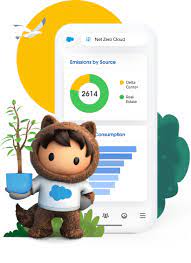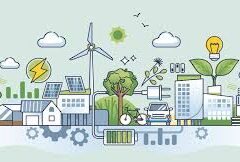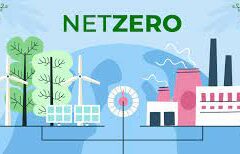Salesforce has unveiled its updated Sustainability Cloud, integrating the newly acquired Slack, alongside the achievement of net zero emissions across its entire value chain and the transition to 100% renewable energy for its operations. Salesforce Updates Sustainability Cloud with Slack.
The company’s climate action plan sets out priorities for advancing towards a 1.5°C future, highlighted by the launch of Sustainability Cloud 2.0. This updated platform empowers organizations to monitor and mitigate carbon emissions effectively.
Sustainability Cloud is now known as Netzero Cloud.
Marc Benioff, CEO and Chair of Salesforce, emphasized the urgent need to address climate change, underscoring Salesforce’s pride in achieving net zero emissions and renewable energy utilization. However, Benioff stressed the importance of continued efforts to engage all businesses in sustainable practices.
These initiatives build upon Salesforce’s ongoing sustainability commitments, including the integration of climate obligations into supplier contracts and the introduction of tools to streamline supply chain emissions tracking. Salesforce also advocates for science-based climate policies and calls for mandatory climate reporting by companies.
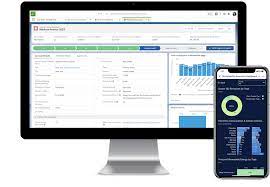
What is the Net Zero policy?
Net Zero policy is that you reduce greenhouse gas emissions as much as possible. Then, any remaining emissions will be re-absorbed by things like the ocean or forests.
What is Sustainability Cloud?
Initially launched in 2019, Sustainability Cloud offers businesses a comprehensive view of their environmental impact, facilitating data-driven strategies to minimize carbon footprints. With the release of Sustainability Cloud 2.0, Salesforce integrates Slack, enhancing collaboration with suppliers post its acquisition. The updated platform includes features such as a carbon-offset ecosystem and tailored climate action plans.
Salesforce credits its own net zero milestone to Sustainability Cloud, which identified impactful opportunities to reduce emissions effectively. Suzanne DiBianca, Chief Impact Officer and EVP of Corporate Relations, emphasized the transformative potential of Sustainability Cloud in empowering customers to combat climate change and reduce carbon emissions.
UN Sustainable Development Goals
To overcome the challenges and achieve the UN Sustainable Development Goals (SDGs) related to climate change, several key obstacles must be addressed:
- Policy and Governance: There is a need for strong, integrated policies and governance frameworks at local, national, and global levels to drive sustainable practices and enforce regulations that align with climate action goals.
- Financing and Investment: Adequate financial resources are essential to support climate-friendly technologies, renewable energy projects, and sustainable infrastructure. Mobilizing investments towards climate-resilient initiatives is crucial.
- Technology and Innovation: Advancements in clean energy technologies, carbon capture and storage, sustainable agriculture practices, and smart urban planning are necessary to mitigate climate impacts and transition to low-carbon economies.
- Public Awareness and Education: Increasing awareness about climate change, its impacts, and the importance of sustainable lifestyles can mobilize public support and drive behavioral change towards eco-friendly practices.
- Partnerships and Collaboration: Addressing climate change requires collective action from governments, businesses, civil society, and communities. Collaborative partnerships can foster innovation and scale up climate solutions.
- Equity and Social Justice: Climate change disproportionately affects vulnerable populations and marginalized communities. Ensuring equitable access to resources, adaptation measures, and climate-resilient infrastructure is essential for inclusive sustainability.
- Biodiversity Conservation: Protecting and restoring ecosystems is crucial for biodiversity conservation and resilience against climate impacts. Conserving natural habitats can also contribute to carbon sequestration.
- Adaptation and Resilience: Building resilience against climate impacts, such as extreme weather events and sea-level rise, is essential to safeguard communities and ecosystems from climate-related risks.
- Transparent Reporting and Accountability: Robust monitoring, reporting, and verification mechanisms are needed to track progress towards climate goals and hold stakeholders accountable for their commitments.
By addressing these obstacles through collective efforts and innovative approaches, we can accelerate progress towards achieving the UN SDGs related to climate action and sustainable development, securing a more sustainable and resilient future for all.
Salesforce Updates Sustainability Cloud with Slack
The Net Zero by Salesforce initiative helps customers manage their environmental footprints and track progress toward net zero. Organizations of all sizes can use this platform to achieve their sustainability goals.
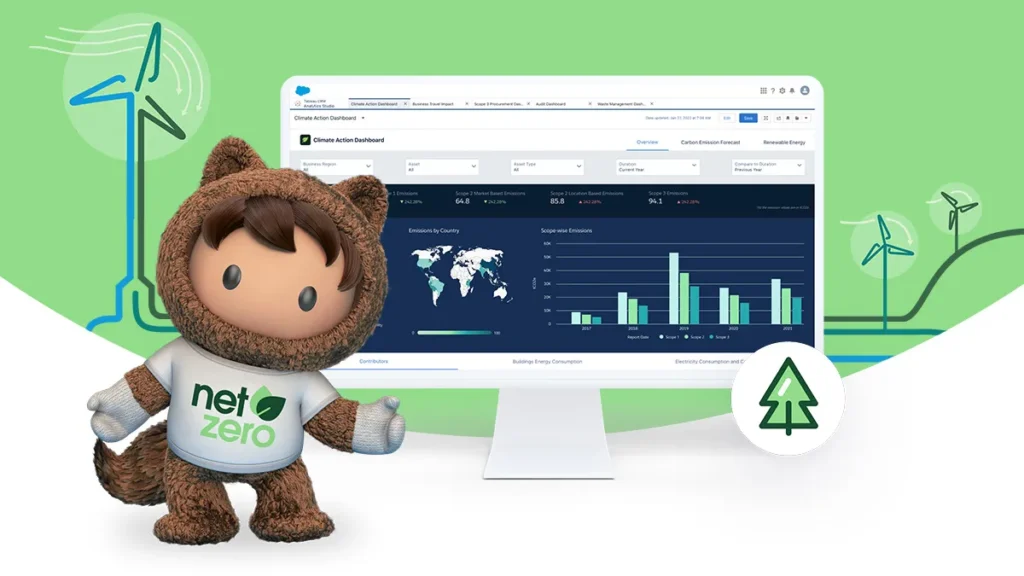
The Net Zero Cloud by Salesforce is a powerful cloud-based platform designed to assist organizations in managing their environmental impacts and achieving net zero goals. Here’s an overview of its features and potential uses:
Key Features:
- Measuring and Reducing Emissions:
- Utilize calculators to track energy consumption and greenhouse gas emissions.
- Access resources to adopt low-carbon technologies and sustainable practices.
- Tracking Progress Towards Net Zero:
- Monitor and analyze your carbon footprint over time.
- Compare performance with other organizations using the Net Zero by Salesforce Leaderboard.
- Reducing Energy Consumption:
- Implement energy-efficient technologies and practices.
- Utilize tracking tools to monitor energy usage and identify areas for improvement.
- Reducing Waste:
- Adopt waste-reducing technologies and practices.
- Track and manage waste generation to minimize environmental impact.
Tools Offered:
- Carbon Footprint Analysis: Visualize and track progress towards climate action commitments.
- Science-Based Targets: Set goals to reduce greenhouse gas emissions aligned with scientific recommendations.
- Supplier Emissions Management: Track scope 3 emissions across your value chain to address supply chain emissions.
- Waste Data Management: Streamline management of hazardous and non-hazardous waste data.
Pros:
- Efficient Sustainability Data Management: Centralize and manage sustainability data effectively.
- Supplier Collaboration: Collaborate with suppliers to address emissions throughout the value chain.
- Predictive Insights: Receive emission predictions, reduction recommendations, and progress tracking towards Net Zero targets.
Cons:
- Costly: The software can be expensive, which may limit accessibility for smaller organizations.
- Limited Support Resources: Lack of available training, webinars, or a free trial version for potential users.
Overall, the Net Zero Cloud offers a comprehensive suite of tools to support organizations in their sustainability journeys, from emissions reduction to waste management. While it has notable benefits, such as advanced data management and supplier engagement, potential users should consider the associated costs and support limitations before implementation.
Content updated November 2023.

